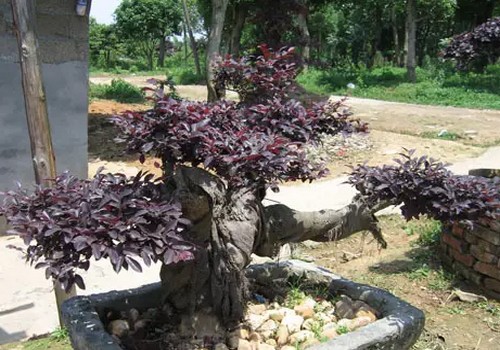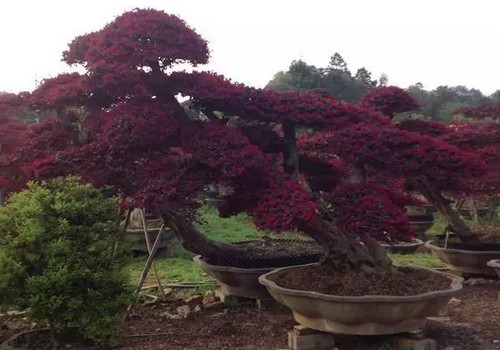Maintenance method of bonsai of Carthamus tinctorius
Carthamus tinctorius is an evergreen plant with bright red new leaves. The leaf color and flower color of different lines are different when they are mature, and the leaf size is also different. The different effects of leaf color and leaf size are mainly considered in garden application. Carthamus tinctorius has luxuriant branches, graceful posture, resistance to pruning, resistance to flat binding, can be used for hedges, can also be used to make stump bonsai, blooming season, full of safflower, very spectacular.

Before transplanting Carthamus tinctorius, the base fertilizer based on rotten organic fertilizer should be selected, combined with spreading or hole application of compound fertilizer, and mix well to avoid root damage. In the growing season, the neutral foliar fertilizer 800-1000 times diluted was used for foliar topdressing and sprayed 2 times 3 times a month to promote new shoot growth. In the southern plum rain season, attention should be paid to keeping good drainage, high temperature and drought season, watering once in the morning and evening, combined with spraying at noon to cool down; in the north, because the soil and air are dry, the soil must be watered in time to keep the soil moist, spray water in autumn, winter and early spring, and keep the leaves clean and moist.
The maintenance and management of safflower bonsai is more elaborate than that of potted flowers. because the soil is less and thin, it is easy to be affected by external influence and the invasion of diseases and insect pests, and it is necessary to control its growth and maintain a certain model. therefore, in addition to watering, fertilization, loosening soil, weeding, changing pots and pest control, more efforts should be made in modeling and pruning to make the stump bonsai maintain a beautiful artistic image.
1. Watering: after potting or changing the basin, the bonsai should be watered until the bottom of the basin flows out, and more water should be sprayed on the tree stump, branches and leaves; water should be watered once the next day after fertilization. Shallow or small pots of wood bonsai should be watered frequently; large or deep pots should master that the soil is not dry or irrigated, and generally pay attention not to make the soil too wet or too dry. Usually, the amount of water and spray water during the growing period is the most in summer; in winter, the dormant period of trees should be watered less, but the basin soil should not be too dry. When it is windy or the weather is too dry, spray more water on the trees, branches and leaves.
2. Fertilization: 7 parts of cake fertilizer (bean cake, peanut cake, rapeseed cake, etc.), 2 parts of chicken dung, 1 part of bone meal, 10 times of water in the tank, and then diluted with 10 times water after complete fermentation. or use all kinds of kitchen waste (eggshell, fish head, chicken head, broken bones, intestines, fish scales, blood water, Amoy rice water, etc.) in the tank after sealed fermentation, take the upper layer of fat water and water 4-5 times diluted. Fertilization should be carried out in the evening on cloudy or sunny days, generally irrigated every 15 days, less or no application in the dormant period, 1-2 times before sprouting in spring, and 3 months after turning the basin. If liquid fertilizer encounters leaves and sprouts, spray it with clean water so as not to affect the growth of leaves and buds. Simu is an acid-loving plant, 1% ferrous sulfate (50kg water plus 500g) should be added to the retting fertilizer and water, or foliar spraying concentration of 0.2% mi 0.3% ferrous sulfate solution, 3-5 times a year. When the secondary wood germinates, 0.1% urea is sprayed 1-2 times, and 0.1% KH 2PO 4 is sprayed once before and after flowering.
3. Pruning: after the wood bonsai is formed, methods such as heart-picking, leaf-picking, bud-picking and pruning should be adopted to keep it in a beautiful shape. Proper density of branches and leaves can improve ventilation and light transmission conditions, reduce the occurrence of diseases and insect pests, and prevent the death of lower branches and leaves.
4. Turning the basin: there is little soil and limited nutrients in the basin, and the soil will harden after a few years, affecting air permeability and drainage. In addition, the old roots were densely distributed in the basin, which affected the germination and growth of new roots, significantly weakened the absorptive capacity, and prevented the normal growth of branches and leaves. Therefore, to regularly turn the basin to change soil, generally small bonsai about 2 years, medium-sized bonsai about 3 years, large bonsai about 4 years. Before turning the basin, you should stop watering and fertilizing. After the soil is dry, remove the mud from the basin, remove half or 2% of the old soil, and cut off the rotten roots, withered roots and some old roots. Pad the broken basin or tile on the drainage hole at the bottom of the basin, then pad a layer of coarse-grained soil at the bottom of the basin, and then plant the successor wood back into the basin (pay attention to maintaining the original shape), fill it with new soil (that is, rotten leaf soil), pour water once according to the solid, and then keep the soil from being dry, shade and spray more water on the tree body, branches and leaves, and then resume normal maintenance after a month.
Bonsai of safflower and wood
5. Shading: the bonsai has less soil and shallow roots, and the hot sun exposure can easily make the soil dry and harden, and the buds, shoots and leaves will be sunburned or died, affecting the ornamental. Therefore, summer must be shaded, set up a shade shed or placed indoors, under the eaves, trees and other places where there is no direct sunlight.
6. Cold protection: bonsai has less soil, shallow roots, poor cold resistance, and is easy to freeze and dry up, or even die. Therefore, winter is not suitable for overwintering outdoors, should be placed indoors, and pay attention to ventilation, room temperature to maintain more than 5 degrees; when the room temperature is more than 25 degrees, you can open the window to avoid excessive growth caused by high temperature, when the room temperature is less than 5 degrees, plastic bags can be covered (when the room temperature is higher than 5 degrees, plastic bags should be removed immediately). When the room temperature is less than 0 degrees, heating methods such as hot water should be used to protect the bonsai from overwintering.
7. prevention and control of diseases and insect pests: bonsai should pay attention to the prevention and control of diseases and insect pests. Because of less soil and weak growth, it is easy to be harmed by diseases and insect pests, so that its normal physiological function is destroyed, so that local branches and leaves are damaged, ornamental is affected, and even plant death is caused.
(1) Prevention and control of diseases and insect pests: the main diseases of bonsai are: root rot, which can be irrigated with 1000 times of 12% green copper EC; coal pollution disease, which can be sprayed with Baume 0.3-0.5 degree stone sulfur mixture; chlorosis, can be sprayed with 0.1% color 0.2% ferrous sulfate solution; powdery mildew, spot disease, etc., can be controlled by methyl topiramate, carbendazim and other spray.
(2) Pest control: red spiders, aphids, inchworms and other pests are the main pests in Jimu bonsai. Permethrin, trichlorfon and trichlorohydrin should be caught or applied in time to kill pests.
Time: 2019-06-01 Click:
- Prev

Maintenance of bonsai of Carthamus tinctorius
Carthamus tinctorius has bright leaves and luxuriant leaves all the year round, especially when it blossoms. It is an ornamental tree with beautiful flowers and leaves. It is often used for color block layout or pruning into a ball, and it is also a good material for making bonsai. Today, the editor will tell you the method of making safflower bonsai.
- Next

The Culture method of Ranunculus
The potted flowers bought in the flower market generally have two kinds of potted flowers cultivated in different substrates, one is cultivated in ordinary soil, the whole flower is strong, but the color is not very bright, and the most important thing is that the water content of the substrate is small, and the plant is easy to wilt if it is not watered in time.
Related
- Fuxing push coffee new agricultural production and marketing class: lack of small-scale processing plants
- Jujube rice field leisure farm deep ploughing Yilan for five years to create a space for organic food and play
- Nongyu Farm-A trial of organic papaya for brave women with advanced technology
- Four points for attention in the prevention and control of diseases and insect pests of edible fungi
- How to add nutrient solution to Edible Fungi
- Is there any good way to control edible fungus mites?
- Open Inoculation Technology of Edible Fungi
- Is there any clever way to use fertilizer for edible fungus in winter?
- What agents are used to kill the pathogens of edible fungi in the mushroom shed?
- Rapid drying of Edible Fungi

